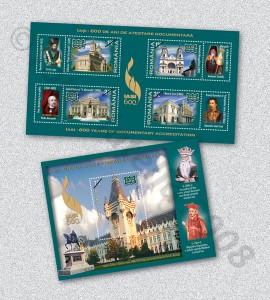 Between 1400 and 1432, Alexander the Good was the ruler of Moldavia and, during his long reign, he managed to organize politically, administratively and ecclesiastically this Romanian province. During his entire reign, the Metropolitan seat of Moldavia was recognized by the Patriarchate of Constantinople. Between 1400 and 1432, Alexander the Good was the ruler of Moldavia and, during his long reign, he managed to organize politically, administratively and ecclesiastically this Romanian province. During his entire reign, the Metropolitan seat of Moldavia was recognized by the Patriarchate of Constantinople.
Between 1400 and 1432, Alexander the Good was the ruler of Moldavia and, during his long reign, he managed to organize politically, administratively and ecclesiastically this Romanian province. During his entire reign, the Metropolitan seat of Moldavia was recognized by the Patriarchate of Constantinople. Between 1400 and 1432, Alexander the Good was the ruler of Moldavia and, during his long reign, he managed to organize politically, administratively and ecclesiastically this Romanian province. During his entire reign, the Metropolitan seat of Moldavia was recognized by the Patriarchate of Constantinople.
Encouraging trade, in 1408, he granted Polish merchants several privileges officially acknowledged in a document where the city of Iasi was also attested.
In 1564, the ruler Alexandru Lapusneanu moved the capital of Moldavia from Suceava to Iasi.
In 1859, the city of Iasi elected the first native ruler for the United Principalities of Moldavia and Wallachia. Between 1859 and 1862, both Iasi and Bucharest were de facto capitals of the Principalities. In 1862, with the unanimous external recognition of the Unification and once the country became known as Romania, Bucharest was designated as the capital city.
Occasioned by the anniversary of 600 years of documentary accreditation for the city of Iasi, Romfilatelia releases a postage stamps issue dedicated to this event named „Iasi – 600 years of documentary accreditation“.
The stamps and the souvenir sheet of the issue illustrate representative edifices for the city of Iasi. The stamp with the face value of RON 1.00 illustrates the Biserica Sfintii Trei Ierarhi/The Church of the Three Holy Hierarchs.
Founded by the ruler Vasile Lupu, the church was constructed between 1637 and 1639. Following the acquittal by Vasile Lupu of the debts for the Holy Tomb and the monasteries on Mount Athos and also grace to the many charitable acts completed by him, the Patriarchate and the Synod of Constantinople sent the Saint Parascheva relics to Iasi as a sign of recognition. These relics arrived two years after the completion of the building, in 1641.
Through its magnificence, The Church of the Three Holy Hierarchs reflects the pursuit for the bright Byzantine world, standing out grace to the sumptuousness of the structures and the traditional forms combined with the precious materials and the impressive decorations.
The stamp with the face value of RON 1.60 presents the Metropolitan Cathedral.
Monumental edifice built according to a rectangular plan with four turrets, the construction of the Metropolitan Cathedral was completed between 1833 and 1839. The idea of building a monumental church belongs to Bishop Veniamin Costachi. Because of the collapse of the central vault, the edifice was left in ruin until 1880. Reinforced according to the architectural plans of Alexandru Orascu and painted by Gheorghe Tatarescu, the Cathedral would be inaugurated in 1887 in the presence of King Carol I and Queen Elisabeth.
The architectonic style is inspired from the late Italian Renaissance forms, whereas the decorative elements, both
interior and exterior, are marked by the Baroque style influence.
The stamp with the face value of RON 2.10 illustrates the building of the „Vasile Alecsandri“ National Theatre.
Considered as the oldest and the most exquisite edifice of its type in the country, the construction of the National Theatre in Iasi was completed between 1894 and 1896.
Built according to plans bearing the signature of some Viennese architects, the structure is a wonderful architectural jewel housing art monuments such as the painted Curtain, representing the allegory of life and the allegory of the Romanian Principalities Unification, the iron Curtain with adorned motives symmetrically disposed, the ceiling painted in pastel colours presenting Elysian allegories and the Venetian crystal chandelier.
The stamp with the face value of RON 3.10 presents the Museum of Unification.
Built in 1806 in the Empire style, the palace hosted Stefan Catargiu, the hetman Constantinica Paladi, sword bearer Mihalache Cantacuzino-Pascanu and, between 1859 and 1865, the ruler Alexandru Ioan Cuza.
The museum hosts both personal objects that belonged to the ruler and numberless documents regarding the language and the traditions of the Romanian people.
The stamp of the souvenir sheet with the face value of RON 7.60 shows the building of the Palace of Culture.
Effigy of the city of Iasi, the Palace of Culture was built in a Neogothic style between 1906 and 1925, according to the designs signed by the architect I.D. Berindei and was inaugurated in 1926 by King Ferdinand I. The Palace hosts the Gothic Hall, the Woivodes Hall, the Henri Coanda Hall and the Carillon Horologe.
The Palace of Culture in Iasi is the home of several important cultural institutions, representative not only for the Moldavian region but also for Romania.
We hereby express our appreciation for the City Hall of Iasi for its support granted for the release of the postage stamps issue.
Issue date: 2008-06-26
















